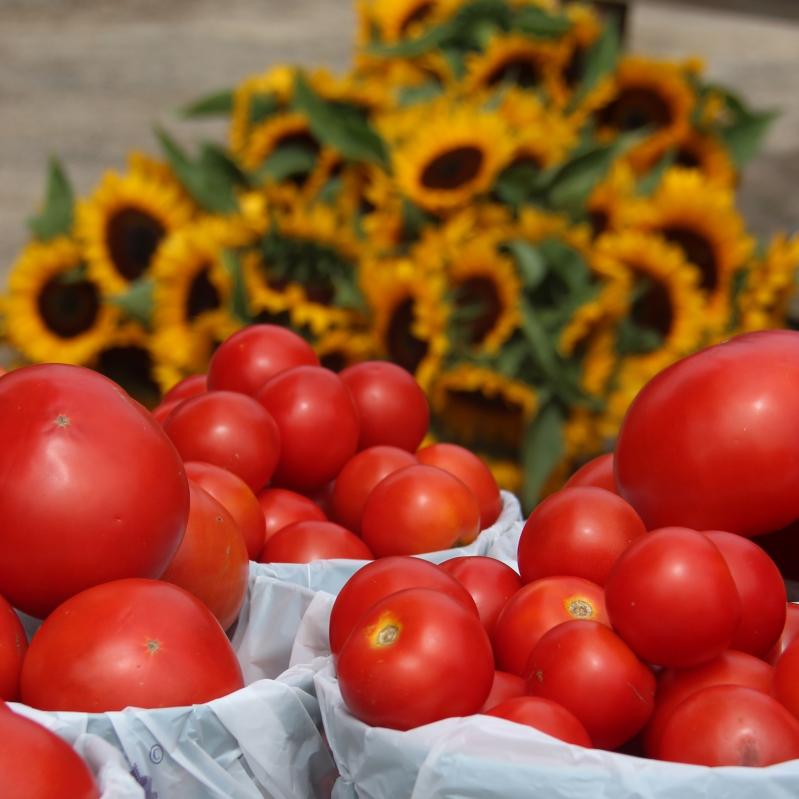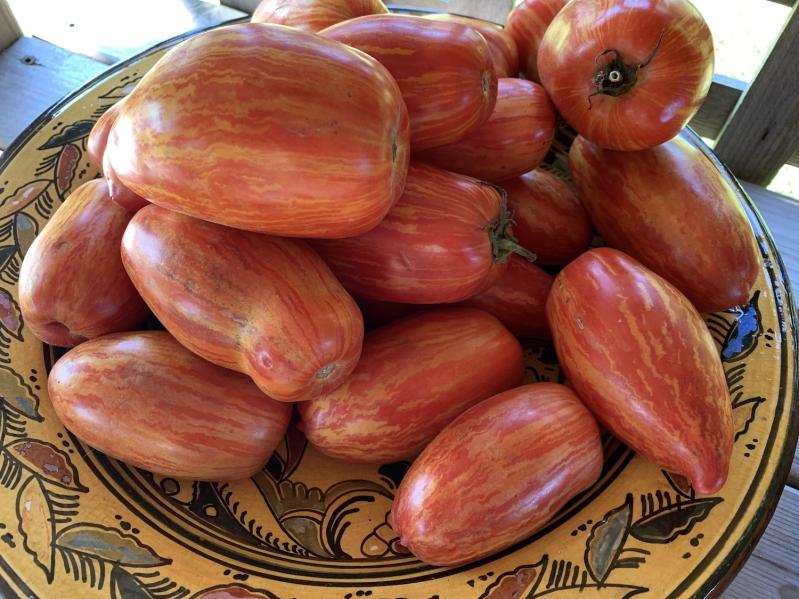First, a confession: You're reading this story because its writer is weirdly obsessed with tomatoes. It's in the Sampson family genes, apparently, because parents, sisters, nephews, and cousins are all obsessed, too. There's nothing quite like that sweet, tart burst of juice in each bite, or the savory, saucy combination of tomatoes and herbs over pasta.
Now that that disclosure's out of the way, we can focus on the task at hand — getting the most out of your tomato plants during their growing season, which ranges from seeding in mid-April to early May to as long into September and October as the sun's lingering warmth will allow. And what tomato tip sheet would be complete without a recipe or two? Here's a guide to growing and enjoying your best tomato-flavored life, thanks to Matthew Quick, the farm manager for the nonprofit Share the Harvest Farm, and Marilee Foster, who typically grows 100 varieties each year on her Sagaponack farm.
Start With the Basics
"One of the most important things is the soil you start them in," said Mr. Quick. This year, Share the Harvest will plant 1,200 individual tomato plants on about a fifth of an acre.
Dried chicken manure — call up Iacono Farm in East Hampton or the North Sea Farm in North Sea to see what's available — will make an excellent soil additive to prep for tomato planting, Mr. Quick said.
"It never hurts to do a soil test," Ms. Foster said, suggesting Cornell Cooperative Extension and the Long Island Cauliflower Association as entities to ask for help in this department. "What you find out is where your Ph is. Tomatoes like a slightly acidic soil. Our soil on the East End tends to be slightly acidic, but if yours is not, lime is how you change the Ph of your soil. A soil test is always good because that tells you how you need to amend your soil before you've even planted anything."
"The other part is getting good seed," Mr. Quick said. The best sources, like a brand called Johnny's, he said, will test their germination rates and let you know what to expect by listing a percentage on the packet.
"And just as important is the sunlight. If you get just a few hours a day, the tomatoes will not do well," he said.
Weed your tomato patch so that the plants are not drained of nutrients by invasive plants.

Feed Your Food
Tomato plants like to be fed, but not necessarily with fertilizer, Mr. Quick said. "We feed ours with bonemeal. You can also use organic bloodmeal." In his experience, it's best to stay away from commercial products like Miracle Grow, and to source compost from places other than the town dump.
"Starve them a little bit," Ms. Foster said. "Don't give them too much water or nutrients. The plant might look a little bit anemic," but it will yield super-tasty fruit.
If you're having a landscaper take care of them — you can sometimes tell who's fertilizing them "based on the color of people's lawns out here," Ms. Foster said — maybe have them pull back from the tomatoes. With over-fertilization, she said, "You generally get less fruit and the fruit can be flabby,
They both say it's important not to overwater. "This is a common mistake that can lead to roots rotting," Mr. Quick said.
"People will say, 'I don’t know what's wrong. I water it every day, but it turned black and died,' " Ms. Foster said.
So, best to closely monitor the settings on those automatic sprinklers if they face your tomato patch.
Take Advantage of the Growing Season
Tomatoes have such a long growing season that dedicated growers can even do multiple plantings. One can go into the ground, weather permitting, in early April; the other, no later than the second week in May. In particular, paste tomatoes for cooking sauces will thrive later into the growing season, so plan out your varieties accordingly.
Pay special attention to the weather forecast. "You can't put tomatoes outside if you're going to get a frost," Mr. Quick said.
You can start them inside, too. "Get a grow kit with lights, or put six to 10 plants under a really sunny windowsill. Keeping them warm is important, especially when they're young."
What's at Stake?
A lot, actually. Keep your tomatoes off the ground by tying them to wood stakes, trellises, or tomato cages to keep them upright. If you don't, Mr. Quick says, "there will be more rot, because you won't have as much airflow. Staking them makes a huge difference."
But don't just set-it-and-forget-it. Ms. Foster recommends keeping a close eye on those stakes. "Multiple times through the season, add additional line clips or whatever device you have to tie them up."
The rules of airflow also applies to the distance between individual plants. "Things shouldn't be planted too close because a locked air mass -- cool, damp air sitting on them all day -- is the worst," Ms. Foster said.
Crop Rotation for Beginners
Ms. Foster is emphatic about this nugget of information: "Never plant your tomatoes where they have been in at least the last three years." It's called crop rotation, otherwise known as "using a different bed next year," she said.
"Don't put it back in the same bed. A lot of people will put their tomatoes exactly where they died last year. When your new tomatoes get going this spring, they're going to be greeted by all those diseases again."
Recipe: Tomato on Toast
This is an easy one, but here's the secret twist: Whereas many people will opt for some sea salt and a light shake or two of black pepper, a slightly more adventurous take on this involves Montreal Steak Seasoning. This blend also includes onion powder, red pepper, and garlic.
1 to 2 large tomatoes
Mayonnaise
Two slices of bread
Montreal Steak Seasoning
Pop your bread in the toaster and set it to the desired crispness. While it's toasting, slice your tomato to your preferred thickness. When the toast is ready, spread on the mayonnaise in a smooth layer, then top with sliced tomato. Sprinkle Montreal Steak Seasoning over tomatoes and enjoy.
Recipe: Josephine Sampson's Meat Sauce
For simplicity, this recipe relies on already canned tomatoes and paste, but if you're up for the challenge, it can easily be augmented with homemade versions.
Ingredients:
2 large cans tomato puree
2 large cans Italian-style crushed tomatoes
12 ounces tomato paste
12 ounces hot water
1 large onion, diced
2 pounds chopped meat
1/4 cup olive oil
1 1/2 Tbsp. salt
1 tsp. pepper
1 Tbsp. sugar
1 Tbsp. dried basil
1 Tbsp. dried oregano
1/4 tsp. garlic powder
Add olive oil to a large pot and brown the onions well over medium heat. Then add the chopped meat and brown that, too. Add salt, pepper, garlic power, basil, and oregano. Add the crushed tomatoes first, then the puree. Stir well over medium heat. Let simmer for half an hour. Then add the tomato paste and 12 ounces hot water, and stir well.
Add sugar, which counterbalances the acidity of the tomatoes. Cook on low heat for three hours, stirring occasionally.
The sauce is so tasty that Josephine's granddaughters like to eat bowls of it even without pasta. It freezes exceptionally well; some Sampson family members even say it tastes better on the second day.

